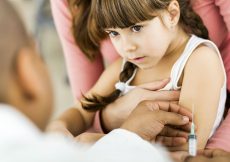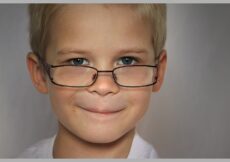Tuberculosis (TB) is a chronic bacterial infection. It is a rare but contagious disease caused by mycobacterium tuberculosis. It mainly affects the lungs but may also cause an impact on the kidney, brain, or spine (1).
Around 1.2 million children under 15 years fall ill with TB every year (2). The Centers for Disease Control and Prevention (CDC) explains that TB in children younger than 15 years is a threat to public health as it indicates a recent transmission. Moreover, TB in young children can be life-threatening (3). Read this post to learn more about the symptoms, complications, diagnosis, prevention, and treatment of TB in children.
Types Of TB In Children
The following are the different stages of TB (1).
- Exposed: This is when the child comes in contact with a TB-positive person but has a negative TB skin and blood test, a normal appearance of the lungs on an x-ray, and has no correlating symptoms.
- Latent TB infection: This happens when the child has TB bacteria in the body but is asymptomatic. The child’s immune system causes the TB bacteria to be inactive. They test positive for TB on a blood or skin test but have a normal chest x-ray and no symptoms. They cannot spread the infection to others.
- TB disease: This is when the child exhibits the signs and symptoms of an active infection. Their blood or skin test can be positive or negative, but the testing shows active disease in the lungs or other sites in the body. They may spread it to others if the infection is in the lungs and left untreated.
Causes Of TB In Children
TB is caused by the bacteria Mycobacterium tuberculosis (M. tuberculosis). Most children infected with M. tuberculosis do not develop active infection and remain latent.
The bacteria is spread through the air when an infected person coughs, sneezes, speaks, sings, or laughs. A child becomes infected only on repeated contact with the bacteria. It does not spread by sharing personal items such as utensils, towels, clothing, bedding, cups, a toilet, or other items that a person with TB has touched (1).
Symptoms Of TB In Children
The symptoms of TB differ are not the same in every child. They may vary according to the child’s overall health, age, and severity of the condition. Some symptoms of TB in children include (1):
- Fever
- Weight loss
- Poor growth and development
- Cough
- Swollen glands may also drain fluid through the skin for some children
- Chills
The following are some symptoms of active TB in older children.
- Cough that lasts longer than three weeks
- Chest pain
- Blood in sputum
- Fatigue
- Weakness
- Swollen glands that may also drain fluid through the skin for some children
- Appetite loss
- Fever
- Weight loss
- Chills
- Night sweating
Some children infected with TB, especially those below four years or who have started puberty, may spread the TB through the bloodstream. It may affect any vital organ in the body or cause complications such as meningitis. The treatment for such an infection needs extensive treatment (4).
Risk Factors And Complications Of TB In Children
The following factors may make children more susceptible to TB infection (5) (6).
- Living with or being exposed to those with TB
- Populations who are medically underserved
- Homeless population
- Living in countries where TB is prevalent
- Children living in group settings
- Children with impaired immune systems
- Children with diabetes or HIV
- Children taking medicines such as corticosteroids or undergoing chemotherapy as it weakens their immune system
Source: The Centers for Disease Control and Prevention
Diagnosis Of TB In Children
The doctor will ask for a detailed medical history, family history, and note all symptoms of the child. They will also examine all physical symptoms of the child.
TB is diagnosed with a tuberculin skin test (TST). A small amount of testing material is injected into the top layer of the skin, and if a bump develops within the next two to three days, the test indicates positive for TB infection. The doctor may perform a blood test called QuantiFERON-TB Gold (QFT) or interferon-gamma release assays (IGRA), chest x-ray, sputum test, CT scan, or bronchoscopy for the child (7).
A TB skin test may be advised for children:
- With exposure to individuals with TB in the last five years
- With an x-ray that looks like TB
- Having symptoms of TB
- Who come from countries where TB is prevalent
Yearly skin tests for TB are advised for children who have HIV or live in a detention facility. Children exposed to high-risk people should be tested every two to three years.
Children may be asked to get TB skin testing from ages four to six and 11 to 16 if they:
- Have a parent from a high-risk country
- Have traveled to a high-risk area
- Live in a densely populated area (6)
Treatment For TB In Children
The treatment plan for TB is designed based on the child’s age, overall health, medical history, the extent of the disease, tolerance towards specific medicines, procedures, or therapies, and expectations from the course of the disease.
The treatment may include (5):
- Short-term hospitalization
- Medicines
- For latent TB in children between age two and 11— a 12-month course of isoniazid
- For active TB in children—a combination of three to four medicines, including isoniazid, rifampin, pyrazinamide, or streptomycin for up to six months or more.
Children usually feel better within a few weeks after the treatment starts. After two weeks of treatment, the child is no longer contagious. However, it is essential to complete the entire course of medication for maximum efficacy.
Prevention Of TB In Children
The main way to prevent TB in children is to take the BCG (Bacillus Calmette–Guérin) vaccine. Serious TB complications can be prevented by treating latent TB so it does not become active. Diagnosing and treating active TB cases among adults can help prevent the spread of TB to children.
If a child has TB, ask the doctor when it is safe to return to school. In addition, children in homes with active TB cases should be screened and provided preventive treatment if they tested positive for latent TB infection to contain the infection (8).
When To Call The Doctor?
There may be some side effects from the TB medicines. Call your healthcare provider if you notice the following symptoms (7).
- Nausea
- Vomiting
- Loss of appetite
- Yellowish discoloration of the eyes or the skin
- Abdominal pain
- Tingling sensation of the toes or the fingers
- Skin rashes
- Spontaneous bleeding
- Feeling dizzy
- Tingling or numbness around the mouth
- Easy bruising
- Blurred vision
- Ringing sensation in ears
- Hearing loss
Frequently Asked Questions
- What is multidrug-resistant TB (MDR TB)?
When TB bacteria become resistant to two or more of the most important TB medicines— INH and RIF, it is called multidrug-resistant, or MDR TB. Children with MDR TB disease need special medicines. However, these medicines may not be as effective as the usual TB medicines and have more side effects (7).
- What happens if my child skips one dose?
If the child misses one dose, skip it and take the next dose as scheduled. Ensure your child’s healthcare provider is informed when this happens (7).
- Why does the treatment for TB take so long?
The duration of treatment for TB is long because the TB bacteria take more time to die. It takes at least six months to clear up all the bacteria from the child’s body (7).
- How can I keep my child from spreading TB?
Completing the entire course of medicines as advised is the best way to contain TB infection. Also, encourage the child to–
- Cover their mouths with tissue paper when they cough, sneeze or laugh.
- Put the tissue in a closed bag and throw it away.
- Stay at home and away from school.
- Avoid proximity or close contact with other children when sick.
- Sleep in separate rooms (for elder kids) when unwell (7).
TB is not a disease of the past. Contact your healthcare professional if your child is exposed to a TB-positive patient or exhibits symptoms similar to a TB infection. Prevention is the best way to eradicate TB. If your child is diagnosed with TB, ensure the completion of the entire course of treatment.
References:
MomJunction’s articles are written after analyzing the research works of expert authors and institutions. Our references consist of resources established by authorities in their respective fields. You can learn more about the authenticity of the information we present in our editorial policy.
The following two tabs change content below.




































